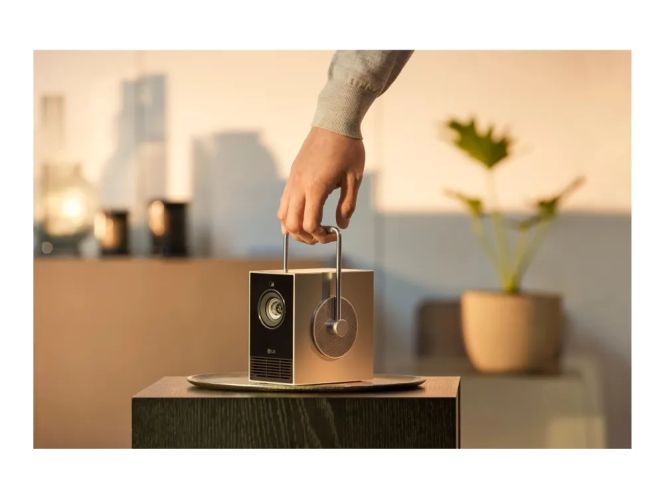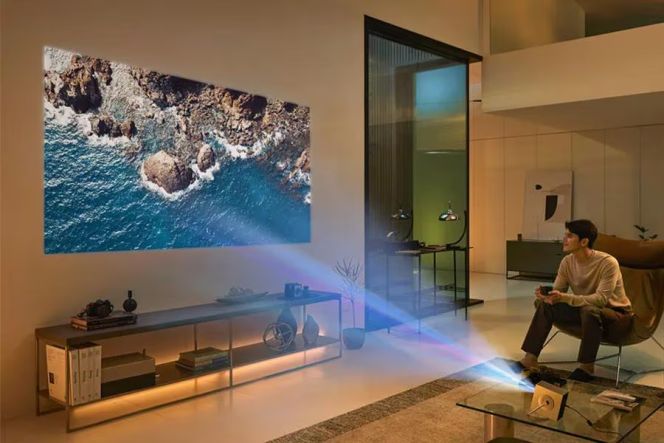TECH REVIEW – While it may not be the brightest portable projector out there, the LG CineBeam Q HU710PB is a compact and impressively equipped RGB laser projector that delivers a wide color gamut, making it an excellent choice for small spaces or for use on the go.
The market for compact portable projectors is still a niche, but major brands like Samsung and LG are starting to pay attention. LG’s first attempt strikes a fine balance between performance and design. Their approach to the portable smart projector focuses heavily on aesthetics, offering premium specs for the category while targeting plug-and-play scenarios rather than full-blown home theater use. The CineBeam Qube HU710PB (thankfully shortened by LG to just “CineBeam Q”) is a relatively compact rectangle with a rotating stand that also functions as a carrying handle. LG has finished the CineBeam Q with polished metal all around, and the aesthetic blend of circles and squares gives it a unique, modern-steampunk vibe, setting it apart as one of the more attractive options in its class.
Always Ready, Watch Anywhere
The CineBeam Q features 4K resolution DLP technology with a laser light source that offers 500 lumens of brightness and a contrast ratio of 450,000:1. The focus is motorized, but the zoom is fixed – to adjust the size of the image, you have to physically move the projector closer to or further from the wall or screen (more on that later). LG uses webOS across its consumer video products. I’ve been covering consumer electronics long enough to have been part of the Palm’s original webOS phone launch, and I haven’t always been a fan of how it’s used in today’s TVs. On my C2 77-inch OLED 4K TV, webOS drives me crazy because the TV is connected to multiple sources via an A/V receiver, and all I want is for it to act as a dumb monitor, but webOS insists on being a full computing and entertainment system. However, on the CineBeam Q, webOS proves to be a huge plus compared to the limited Android TV implementations: all major streaming apps, including Netflix, are available. webOS also boots up quickly, eliminating the waiting time that is common with Android TV projectors before accessing content. There’s a built-in 3-watt mono speaker, which, if it sounds underwhelming, that’s because it is.
While the built-in speaker does reasonably well in terms of clarity and tone, it is undeniably mono, lacks any semblance of a soundstage, and doesn’t get very loud. This was one of the CineBeam Q’s biggest drawbacks for me. LG is bundling the XBOOM 360 XO2TBK, a 360-degree Bluetooth speaker, with the projector if purchased directly from them. At LG’s US headquarters, this was a great combination. But in my home, without the additional speaker, the CineBeam Q was hard to hear over its fan and my air conditioner, offering little in the way of a cinematic audio experience. Unlike most portable projectors, the CineBeam Q does not have an internal battery. The upside is that you’ll never need to recharge it or worry about the projector running out of juice during a long movie like Oppenheimer. The downside is that you’ll always need a power outlet nearby. Many people buy portable projectors for outdoor use, and this requirement could pose a challenge. Setup requires an LG account, allowing LG to track and sell your viewing data (if there’s a way to opt out, I didn’t find it). I also found the setup frustrating using the remote until I realized that the remote’s infrared emitter is quite weak; you have to point it directly at the back of the projector rather than at the content. Even after setup, I occasionally found myself needing to point the remote at just the right angle to get my selection to register. IR emitters are 10-cent parts, and it seems LG was willing to sacrifice usability to save 5 cents.
Fan Noise and Placement Challenges
All projectors have fans, and manufacturers love to tout how quiet they are at their lowest settings (25 dB according to LG’s website). In real-world conditions, I wasn’t that impressed. It’s not loud compared to genuinely loud things, but I measured 42.5 dB three feet away from my seating position. The fan noise is definitely noticeable, and the pitch of the sound can be a bit distracting during quieter scenes, even when connected to my full home theater surround sound system. Traditional projectors have lens shift options to perfectly align the image with a fixed or retractable screen. Portable projectors are less particular about their placement: they use fixed lenses and automatic digital keystoning to adjust the image to any surface from any angle.
This process sacrifices resolution for convenience, and since these portable projectors are usually meant for more casual use rather than for cinema purists, this trade-off is understandable. The auto keystoning on XGIMI and Nebula projectors is slightly faster and more flexible, but LG’s implementation should be sufficient for most users’ smart projector needs. That said, when projecting off-axis onto my 100-inch screen, I could easily notice the loss of clarity from its full 4K resolution. No projector performs well in a brightly lit room. However, for a projector with just 500 nits of brightness, I was surprised by its apparent brightness with moderate room light control. LG claims a 450,000:1 contrast ratio, and while it doesn’t achieve true blacks, the CineBeam Q provides excellent shadow detail in a dark room. The colors are another highlight: in Cinema Mode, they are rich and vibrant, and while watching Fallout on Amazon Prime Video, I could identify the setting just by the color palette.
Three Projectors, Three Experiences
I compared the LG CineBeam Q with two other projectors to see how it stacks up: my older Sony VPL-HW40ES, a 1080p SXRD projector rated at 1700 lumens, and the XGIMI Horizon Ultra, a dual LED/laser 4K HDR projector with a brightness of 2300 lumens. To give each projector the best chance to shine (pun intended), I watched Encanto on 4K Blu-ray on all three. The Sony may boast 1700 lumens and pleasant colors, but its black levels are terrible, and its cinema mode appeared relatively dim on my 100-inch, 1.1 gain screen. (I paid $2000 for this projector less than ten years ago. Sigh.) By contrast, the LG was surprisingly good: much brighter, with better color saturation and sharper resolution, even when slightly off-center, while the Sony was permanently mounted and aligned on my ceiling.
With some lights on, the picture looks decent; with lights off, the image pops like an LED TV (though the CineBeam is still not as bright as miniLED or as contrast-rich as OLED). With full lights on, the image is viewable but just barely. It’s still a projector, after all. Keep this in mind if you plan on using it to watch sports – some light control is necessary. The XGIMI is simply in a different league: it costs $500 more than the LG and isn’t very portable. The XGIMI Horizon Ultra’s resolution, color fidelity, and highlights are noticeably superior in all lighting conditions. The 4K HDR colors become iridescent, contrast improves, and there is significantly more detail visible in the image compared to the LG.
Pretty Little Device, But a Bit Too Noisy
The CineBeam Q’s fan is a bit too loud, its speaker isn’t loud enough, and at HUF 499,000, it’s on the expensive side for a 4K projector that outputs just 500 lumens. However, it offers brightness and color performance better than the specs might suggest, with an incredibly stylish design and one of the best TV operating systems for streaming. There are no hurdles to get Netflix running – there’s even a Netflix button on the remote. And it’s so pretty that you could leave it on a coffee table all the time.
Get Netflix working – there’s even a Netflix button on the remote. It’s so pretty that you can leave it outside on a coffee table all the time.
-Gergely Herpai (BadSector)-
Pro:
+ RGB laser light source with a wide color space
+ Unique, portable design with a retro feel and automatic adjustment functions
+ Connect to two Bluetooth speakers or headphones at the same time
Contra:
– Limited brightness
– No analog audio output
– No infrared sensor on the front of the projector
LG CineBeam Q HU710PB
Design/Software - 7.6
Image Quality - 7.5
For Gamers - 8.1
For Movie Watching - 7.6
Value for Money - 7.1
7.6
GOOD
The LG CineBeam Q HU710PB is a stylish but pricey portable projector that offers excellent color and good brightness for its category. While its fan can be noisy and the built-in speaker lacks power, the webOS system provides easy navigation and quick access to streaming services. The design is uniquely aesthetic and practical, making it a viable option even for travel.



















Leave a Reply